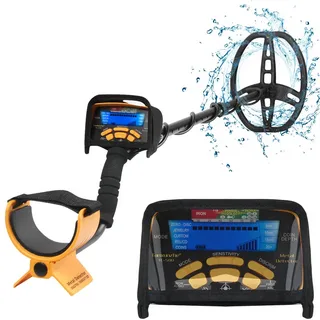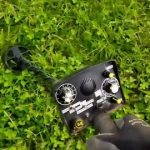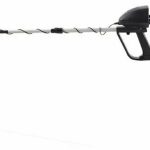Are you eager to uncover hidden treasures buried beneath the surface? Look no further than a gold detector to assist you in your quest. In this ultimate guide, we will explore the world of gold detectors and equip you with the knowledge and skills needed to unearth valuable finds. Whether you’re a seasoned treasure hunter or a novice in the field, this comprehensive guide will provide you with the essential information to maximize your success. Join us as we delve into the world of gold detection and unlock its potential for uncovering hidden treasures.
Uncover Hidden Treasures with a Gold Detector: Your Ultimate Guide is a comprehensive resource for anyone interested in using a gold detector to find hidden treasures. This practical guide covers everything from choosing the right equipment to understanding the various techniques and strategies for successful treasure hunting. You’ll learn about the different types of gold detectors available, how to properly use them, and the best places to search for gold and other valuables. Whether you’re a beginner or an experienced detectorist, this guide will help you take your treasure hunting skills to the next level.
The Ultimate Guide to Choosing the Best Gold Detector

Are you a gold enthusiast looking to strike it rich? Using a gold detector can greatly increase your chances of finding valuable nuggets and flakes. These specialized metal detectors are designed to ignore other metallic objects and hone in on the distinctive magnetic properties of gold. By learning how to properly use and adjust your gold detector, you can uncover hidden treasures in the most unlikely places. Whether you’re a beginner or a seasoned prospector, utilizing a gold detector can open up a world of opportunities for finding gold in rivers, streams, or even in your backyard.
The Ultimate Guide to Choosing the Best Gold Detector is a comprehensive resource for those looking to invest in a quality detector for gold prospecting. It covers a range of important considerations, including the type of gold you’ll be searching for, the terrain you’ll be exploring, and your level of experience. The guide also provides detailed reviews of some of the top gold detectors on the market, along with tips for getting the most out of your investment. Whether you’re a beginner or a seasoned prospector, this guide is designed to help you make an informed decision and find the best gold detector for your needs.
Top 10 Gold Detectors for Amateur and Professional Prospectors

1. Minelab GPZ 7000 – This high-performance detector is known for its depth and sensitivity, making it a top choice for professional prospectors.
2. Garrett AT Gold – This detector is a popular choice for amateurs due to its easy-to-use features and ability to detect small gold nuggets in various terrains.
3. Fisher Gold Bug 2 – Known for its high frequency and ability to detect small gold nuggets, this detector is a favorite among experienced prospectors.
4. Minelab SDC 2300 – This compact and waterproof detector is highly recommended for detecting gold in challenging terrains such as salty or mineralized ground.
5. White’s Goldmaster GMT – This detector is equipped with advanced ground tracking capabilities, making it suitable for both amateur and professional prospectors.
6. Nokta Makro Gold Kruzer – With its high-performance and versatile features, this detector is a popular choice for prospectors of all skill levels.
7. Minelab Equinox 800 – This multi-purpose detector is highly praised for its gold prospecting capabilities, offering various frequencies and search modes.
8. XP Deus – Known for its lightweight and wireless design, this detector is favored by prospectors who appreciate its advanced features and customizable settings.
9. Garrett ATX – This detector is designed to withstand extreme conditions, making it a top choice for professional prospectors working in challenging environments.
10. Tesoro Lobo SuperTRAQ – With its high sensitivity to small gold nuggets and user-friendly design, this detector is a great option for both amateur and professional prospectors.
How to Use a Gold Detector: Tips and Tricks
See also: garrett detector gold

When using a gold detector, it’s important to familiarize yourself with the specific features and settings of your device. Be sure to carefully read the user manual and understand how to adjust the sensitivity, discrimination, and ground balance settings. Additionally, it’s helpful to practice using the detector in different environments to understand how it responds to various types of soil and mineralization.
When searching for gold, it’s crucial to pay attention to the sound and visual indicators on the detector. Different devices may have varying signals for detecting gold, so it’s important to learn and recognize the specific signals for your detector. Additionally, using headphones can help to clearly hear the detector’s signals, especially in noisy or crowded areas.
When scanning an area, be sure to move the detector at a slow and steady pace, overlapping your sweeps to ensure thorough coverage. Keep the coil close to the ground and maintain a consistent height to maximize the detector’s efficiency.
It’s also important to be patient and persistent when using a gold detector. Gold prospecting requires dedication and perseverance, as even the smallest gold nuggets may be buried deep underground. Take your time and thoroughly scan an area before moving on to the next location.
Overall, using a gold detector requires practice, patience, and a good understanding of your specific device. By familiarizing yourself with the settings, signals, and techniques for using a gold detector, you can improve your chances of finding valuable gold nuggets and other treasures.
Finding Gold: The Benefits of Using a Metal Detector

Finding Gold: The Benefits of Using a Metal Detector
Using a metal detector to search for gold can be an exciting and rewarding experience. Metal detectors allow you to cover a large area quickly and efficiently, increasing your chances of finding valuable gold nuggets. They can also help you locate gold in areas where it may be difficult to spot with the naked eye, such as in heavily mineralized soil or underwater.
Metal detectors are relatively easy to use and can be used by people of all ages and skill levels. They can be a fun and engaging hobby for individuals or a valuable tool for professional gold prospectors. Additionally, metal detectors are a non-invasive way to search for gold, minimizing the impact on the environment compared to other methods of gold prospecting.
In addition to finding gold, metal detectors can also help you discover other valuable treasures such as coins, jewelry, and historical artifacts. They can be used in a variety of environments, including parks, beaches, and remote wilderness areas.
Overall, using a metal detector to search for gold offers a range of benefits, making it a popular and enjoyable pastime for many people. Whether you are a seasoned prospector or a beginner, metal detecting can be a rewarding way to explore the outdoors and potentially discover valuable treasures.
7 Common Mistakes to Avoid When Using a Gold Detector
1. Not adjusting the settings properly: Many beginners fail to adjust their gold detector settings correctly, causing them to miss potential targets or struggle with unnecessary interference. It’s important to familiarize yourself with the different settings and understand how they can affect your detection abilities.
2. Ignoring ground conditions: Neglecting to account for variations in ground conditions can lead to inaccurate readings and decreased sensitivity. It’s crucial to understand how different soil types and mineralization levels can impact your detector’s performance and make necessary adjustments accordingly.
3. Overlooking proper coil control: Maintaining consistent and appropriate coil control is essential for maximizing your gold detection capabilities. Failure to keep the coil at a consistent height and maintain smooth, even swings can result in missed targets and inconsistent readings.
4. Rushing the scanning process: Many detectorists make the mistake of moving too quickly or haphazardly when scanning an area, which can lead to overlooking potential targets or misinterpreting signals. Taking your time and scanning methodically can significantly improve your chances of finding gold.
5. Disregarding target signals: It’s crucial not to disregard or dismiss faint target signals, as they could indicate the presence of small or deeply buried gold items. Properly investigating all signals, regardless of their strength, is important for maximizing your detection success.
6. Neglecting to ground balance: Failing to properly ground balance your detector can result in decreased accuracy and performance, as well as increased signal interference. Taking the time to ground balance your detector for the specific conditions of your search area is essential for optimal results.
7. Not researching potential locations: Without adequate research and planning, you may end up searching in areas with low gold potential, wasting time and missing out on more promising locations. Utilize resources such as geological maps, historical records, and local knowledge to identify areas with higher likelihoods of gold deposits.
Gold Hunting 101: Understanding Your Metal Detector’s Settings
Gold Hunting 101: Understanding Your Metal Detector’s Settings is a course designed to help beginners understand how to effectively use their metal detector for gold prospecting. The course covers the various settings and features of a metal detector, and provides practical tips and techniques for optimizing its performance. Topics include ground balance, sensitivity, discrimination, and target identification. By the end of the course, participants should have a better understanding of how to use their metal detector to find gold effectively.
The Pros and Cons of Different Types of Gold Detectors
There are several different types of gold detectors available, each with their own set of pros and cons.
VLF (Very Low Frequency) detectors are the most common and are great for general-purpose gold hunting. They are good at detecting smaller gold nuggets but may struggle in highly mineralized ground.
PI (Pulse Induction) detectors are better suited for highly mineralized ground and can penetrate deeper than VLF detectors. However, they may not be as sensitive to smaller gold nuggets.
Multi-frequency detectors use a combination of VLF and PI technology, offering the benefits of both. They are versatile and can be used in a variety of ground conditions, but they tend to be more expensive.
Pros of VLF detectors:
– Good for small gold nuggets
– Lightweight and easy to use
– Generally more affordable than other types
Cons of VLF detectors:
– May struggle in highly mineralized ground
– Limited depth capabilities
Pros of PI detectors:
– Better for highly mineralized ground
– Can penetrate deeper than VLF detectors
Cons of PI detectors:
– Not as sensitive to small gold nuggets
– Heavier and more complicated to operate
Pros of multi-frequency detectors:
– Versatile and can be used in a variety of ground conditions
– Offer the benefits of both VLF and PI technology
Cons of multi-frequency detectors:
– More expensive than other types
– May have a steeper learning curve
Ultimately, the best type of gold detector for you will depend on your specific needs and the type of ground conditions you’ll be detecting in. It’s important to consider factors such as sensitivity, depth capabilities, and cost when choosing the right detector for your gold hunting adventures.
Gold Detecting: A Beginner’s Guide to Getting Started
Gold Detecting: A Beginner’s Guide to Getting Started is a comprehensive book aimed at those who are new to the hobby of gold detecting. It covers everything from choosing the right equipment and understanding the techniques of detection to planning successful expeditions and navigating the legal and ethical considerations of gold detecting. The book is packed with tips and advice from seasoned experts in the field, making it an invaluable resource for anyone looking to take up this exciting and potentially lucrative pastime.
Uncovering Hidden Treasures: The Science Behind Gold Detectors
Uncovering Hidden Treasures: The Science Behind Gold Detectors is a comprehensive guide to the technology and principles behind gold detection. It covers topics such as the electromagnetic properties of gold, the use of different frequencies and coil configurations in detectors, and the role of signal processing in identifying gold targets. The book also delves into the history of gold detection technology and explores recent advancements in the field. Whether you are a hobbyist or a professional prospector, this book can provide valuable insights into maximizing the effectiveness of your gold detector.
Maximizing Your Gold Finds: Advanced Techniques for Detectorists
“Maximizing Your Gold Finds: Advanced Techniques for Detectorists” is a comprehensive guide that delves into the advanced strategies and techniques used by experienced metal detector users to maximize their chances of finding gold. The book covers topics such as understanding the different types of gold deposits and how they are detected, proper use of metal detecting equipment, interpreting signals, and ground balance adjustments. It also discusses advanced search patterns, target recovery techniques, and how to effectively cover ground to maximize your gold finds. Whether you’re a beginner looking to jumpstart your gold prospecting journey or an experienced detectorist looking to improve your skills, this book provides valuable insights and practical tips to help you become more successful in finding gold.












